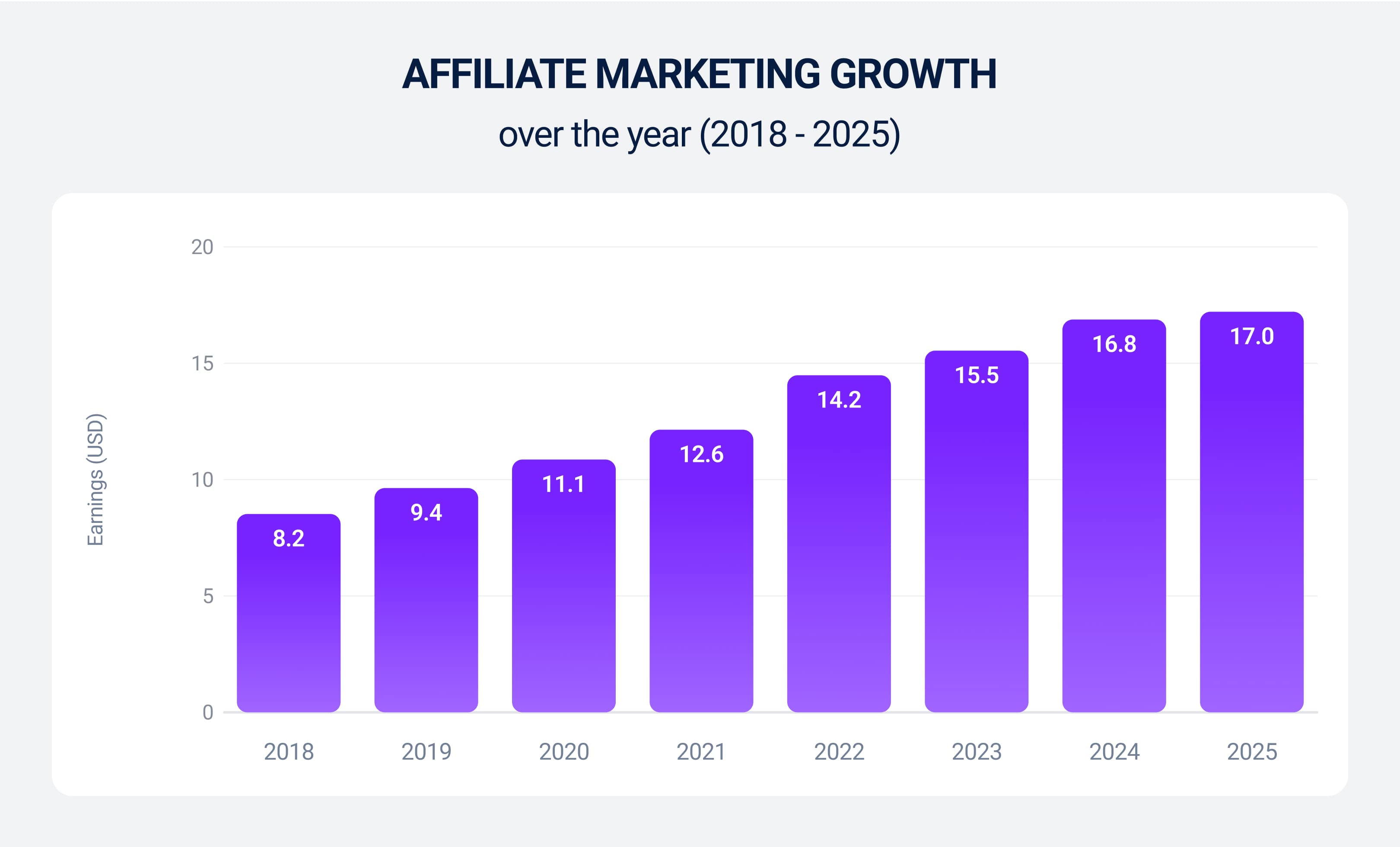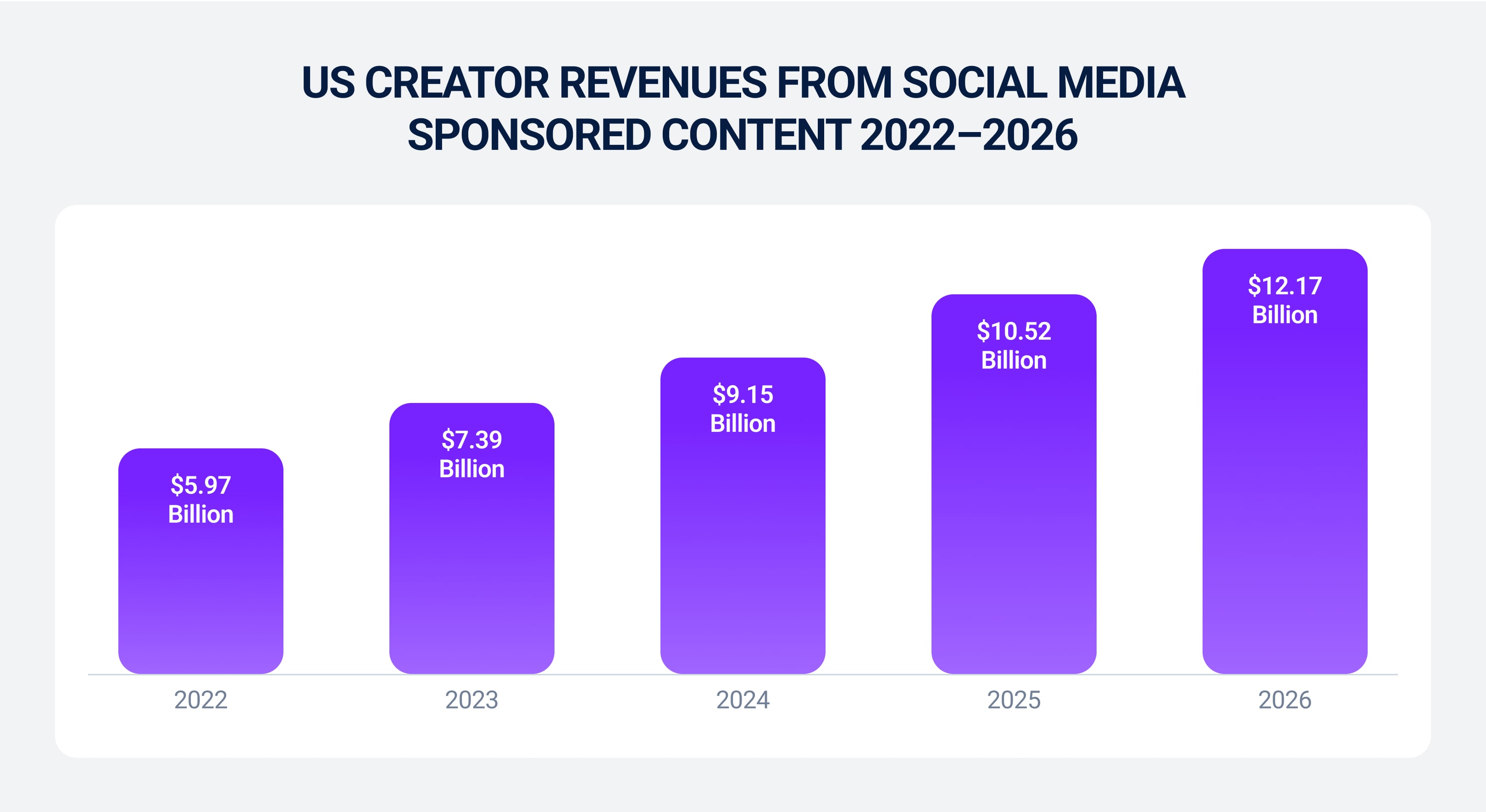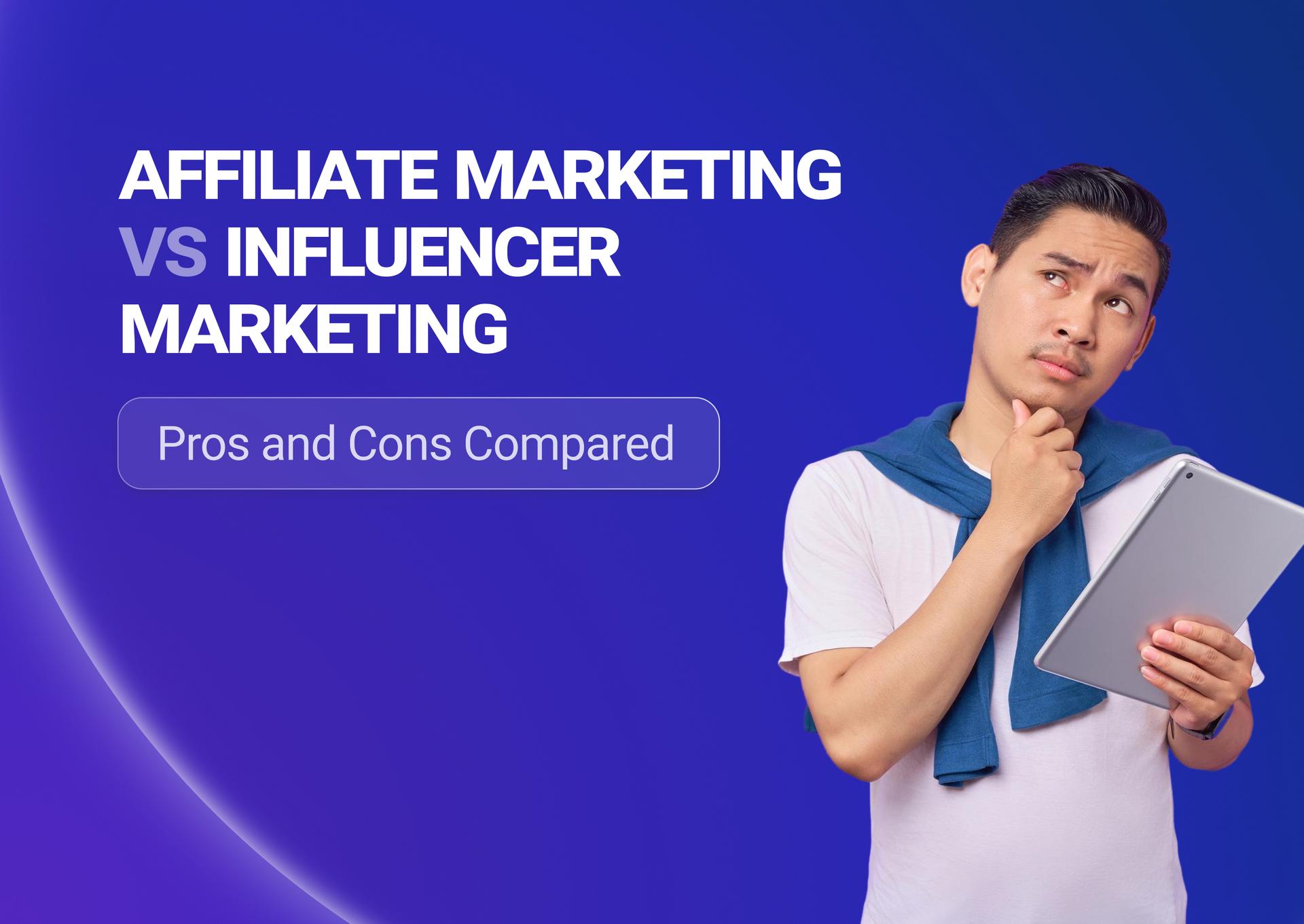Marketing isn’t what it used to be. Gone are the days of direct mail and posters. Today, the place where businesses can get the most reach is the internet. And one of the best ways to exploit internet reach is with affiliate and influencer marketing.
Both affiliate marketing and influencer marketing take advantage of a third party’s pre-existing audiences to advertise and sell. Essentially, the business pays the affiliate marketer or influencer to promote their brand.
With traditional affiliate marketing, that may look something like this:
A web hosting provider pays a renowned web hosting blog to write about (and link to) their services.
Influencer marketing is similar - here’s an example:
A beauty brand pays an influencer to use and advertise their makeup.
They’re pretty similar on the surface. However, dig deeper, and you’ll find that the old “affiliate marketing vs influencer marketing” debate is far more complicated.
Everyone from startups to personal brands and established businesses should listen up. The affiliate marketing industry is worth around $17 billion in 2025 and influencer marketing is just behind at nearly $10 billion. Other brands are making big money with these marketing strategies - you don’t want to miss out.
So, let’s go over the key differences between affiliate marketing and influencer marketing in 2025!
- Differences between Affiliate Marketing and Influencer Marketing
- Pros and Cons of Affiliate Marketing
- Pros and Cons of Influencer Marketing
- Does Affiliate Marketing or Influencer Marketing Drive Better ROI?
- How to Choose the Right Strategy for Your Business
- Expert Tips for Maximizing Each Approach
- Common Mistakes to Avoid in Affiliate Marketing and Influencer Marketing
- Conclusion
Differences between Affiliate Marketing and Influencer Marketing
Here’s a handy side-by-side comparison of affiliate marketing vs influencer marketing:
| Feature | Affiliate Marketing | Influencer Marketing |
|---|---|---|
| Payment model | Commission per sale | Fixed fee or product exchange |
| Measurement | Performance-based | Reach & engagement |
| Control | More scalable & automated | More creative input |
| Risk | Low risk for brand | Higher risk for brand |
| Longevity | Evergreen content | Shorter lifespan unless repurposed |
We might say that affiliate and influencer marketing have slightly different goals. Okay, the brand wants to make sales. But affiliate and influencer marketing models go about this in different ways:
With affiliate marketing, the objective is very much click-based. The affiliates earn a commission for promoting and driving sales (or other actions) through special tracking links.
With influencer marketing, the idea is more to promote brand awareness or engagement (and eventually sales).
There are differences beyond that, too. One of the main ones is how payment is made:
- Affiliate marketing payment - commission-based (the affiliate earns a commission for each action).
- Influencer marketing payment - fixed fee (the influencer charges a flat rate for the work).
Of course, that also means affiliate marketing is “lower risk” for businesses as they only pay the affiliate when they actually get what they want. With influencer marketing, they might pay upfront without getting their desired outcome.
Pros and Cons of Affiliate Marketing
Let’s tackle one at a time. We’re going to start with affiliate marketing as it’s a more established marketing technique.
Pros:
- Pay for performance - you only pay the affiliate based on how well their efforts perform. There’s no prediction involved.
- Scalable - some companies have literally hundreds, even thousands, of affiliates promoting them. It’s very simple to expand as your budget permits.
- Cost-effective - almost no upfront cost compared to influencer fees, which also means less risk.
- Extended reach - affiliates have their own audiences - audiences you might not otherwise reach.
- SEO & content boost - affiliate content (blogs, reviews) can improve search visibility with minimal effort from you.

Cons:
- Lower margins - you may make less as you’re giving up a percentage of each sale to affiliates.
- Lack of brand control - you’re not in complete control of the affiliate’s messaging, which could clash with your brand image.
- Fraud risk - unfortunately, things like cookie stuffing, fake leads, and misleading promotions are not unheard of in affiliate marketing.
- Delayed ROI - it can take a while to build an effective program (and even longer to start actually profiting from it).
Pros and Cons of Influencer Marketing
Influencer marketing is a newer art form. But it’s growing. Influize found that around 50% of marketers now work with influencers as part of their strategies. If you open up Instagram or TikTok right now, you’ll probably see it in action!
Let’s see how it stacks up against affiliate marketing:
Pros:
- Authenticity - with affiliate marketing, you’re targeting people searching for services you provide. They don’t necessarily know the affiliate. Influencers, on the other hand, already have loyal, engaged audiences that trust them.
- High engagement - posts outperform ads in terms of likes, comments, and shares.
- Brand awareness - it’s ideal for quickly reaching new demographics or launching products.
- Creative content - influencers are ready-made content pros. They know what works and what doesn’t, so you can get high-quality creative content that can be repurposed across your own channels.
- Targeted marketing - you don’t have to partner with Kim Kardashian. Micro-influencers in niche markets can target very specific audiences effectively!

Cons:
- Higher upfront cost - top influencers charge thousands per post and even micro-influencers expect compensation.
- Hard to track ROI - you’re going for engagement, not clicks. But that can be much harder to measure than CTR.
- Limited control - you can't fully control what influencers say or how they deliver your message.
- Fake followers & engagement - not all followers are genuine. Some influencers are known to inflate their metrics with bots or engagement pods (which are useless for your purposes).
- Short-term impact - a single post probably won’t create long-term results unless part of a bigger strategy.
Does Affiliate Marketing or Influencer Marketing Drive Better ROI?
This is a tough question to answer. In part because affiliate marketing and influencer marketing have very different goals.
Affiliate marketing is generally easier to track in terms of “pure ROI”. After all, success basically comes down to how many “actions” (usually click-throughs) are carried out. With the right software, you can very easily see how many visitors come in through affiliate links and how many sales resulted from those visits.
It’s a little more complicated with influencer marketing. You’re not necessarily measuring success with CTR. Your goal is to expand your brand awareness and associate your brand with the right audience. There’s no definitive way to say how many sales resulted from an influencer or even a celebrity partnership.
We should point out here that ROI estimates for affiliate marketing vs influencer marketing are available. But they should be approached with caution. It’s very hard to get accurate figures here.
- Some studies suggest an average ROI of $15 per $1 spent for affiliate marketing.
- Research suggests an average ROI of around $6.50 per $1 spent for influencer marketing.
GROW YOUR INSTAGRAM FOLLOWING VIA OUR CELEBRITY CAMPAIGNS
Leverage the power of the worlds A-list celebrities to grow your Instagram every month
VIEW CAMPAIGNSHow to Choose the Right Strategy for Your Business
It’s time to weigh up affiliate marketing vs influencer marketing for your business. Which is right for you?
There are a few factors you can take into account to help make your decision:
- Define your primary goal - influencer and affiliate marketing serve different purposes. What do you want to achieve? If you want to drive conversions or grow long-term passive revenue, then affiliate marketing could be better. If, however, you’d rather build brand awareness or, say, launch a new product to a niche community, find an influencer.
- Assess your budget - if you’re working with a higher budget and have found a specific influencer who you have a lot of faith in, influencer marketing can be well worth it. But if you’re a smaller company (or a startup) who can’t afford a high-risk investment, affiliate marketing may be safer.
- Consider your product type - as we all know from our adventures online, influencer marketing really shines when it comes to things like beauty and lifestyle products, whereas affiliate marketing is better-suited to software and services.
- Assess time horizon - how much time do you have to pack a punch? Do you want to develop a strategy for long-term, compounding growth? Affiliate marketing stands out. Want a punchy short-term campaign that shines bright? Go for influencer marketing.
Don’t forget: you don’t necessarily have to choose between the two. Many successful brands use both affiliate and influencer marketing strategies.
Expert Tips for Maximizing Each Approach
There are both good and bad ways to do both affiliate and influencer marketing. It’s not so much about the approach you choose, but how you go about it that counts.
Here are some pro tips that should help you maximize ROI with both affiliate marketing and influencer marketing:
For Affiliate Marketing
These five tips should help you pull off a smooth, lucrative affiliate marketing campaign:
- Choose the right affiliates - affiliates are representing your brand. Make sure you vet them for audience trust and content quality, not just reach. Take time to research their blogs and channels and make sure they’re aligned with your interests.
- Master onboarding - take the time to get to know your affiliates, but also to teach them about you. Make sure they “feel” your brand and give them all the materials they need to succeed from day one.
- Provide high-converting assets - it’s not all down to the affiliate. It’s also your job to provide custom landing pages and promo codes that will turn clicks into conversions. A/B testing is a good idea!
- Track everything - look beyond sales. Monitor clicks, conversion rates, top-performing pages, and more. Use affiliate software like Impact, Refersion, PartnerStack, or Post Affiliate Pro.
- Incentivize performance - you have to keep affiliates motivated. One of the easiest ways is to gradually increase commission percentage in tiers (say 10% for <$500/month, 15% for $500+).
For Influencer Marketing
Here are some proven ways to maximize your influencer marketing performance:
- Vet influencers thoroughly - don’t cut corners here or get blinded by follower counts. Focus on things like engagement rate, comment quality, and past brand collaborations. For deep analysis, try tools like Upfluence, HypeAuditor, Modash, or CreatorIQ.
- Give creative freedom - no one knows their audiences like the influencers themselves. So let them tailor the message. Studies show audiences respond better to authentic storytelling, not scripted ads.
- Track campaigns properly - likes are one thing. But more important are impressions, engagement, saves, shares, and conversions.
- Repurpose influencer content - a post doesn’t have to be “use once and throw away”. You can often get usage rights and re-use content in email campaigns and web videos. This also provides a kind of “social proof” as it’s coming from a third party.
- Think long-term - ambassador relationships are more important than one-off posts.

Common Mistakes to Avoid in Affiliate Marketing and Influencer Marketing
It’s 10X easier to mess up a marketing campaign than succeed at one.
To make sure everything goes well, here are some bonus tips: common mistakes to avoid in both affiliate marketing and influencer marketing.
Common Mistakes in Affiliate Marketing
Too many businesses fall into these traps when affiliate marketing for the first time:
- Treating it as “set and forget” - you can’t just launch a program and expect sales to roll in. You’re going to have to regularly put legwork in recruiting and motivating affiliates.
- Accepting any affiliate - you should avoid poor-quality affiliates at all costs. They can damage your brand image if you’re not careful.
- Offering weak commissions - a 2.5% commission rate isn’t going to inspire dedication. Anywhere from 5% to 50% is normal - research competitors and find a fair price.
- Lack of tracking/attribution - without solid tracking, you can’t measure true ROI or pay accurately.
Expecting fast results - it can take months to see ROI on affiliate programs. Don’t expect to get instant results!
Common Mistakes in Influencer Marketing
Even businesses familiar with affiliate marketing may struggle to make an impact with influencer marketing. Here are a few mistakes to steer clear of:
- Choosing influencers based on follower count - followers are a good marker, but they’re not the be-all-and-end-all. Fake followers can result in low engagement and low ROI for your campaign.
- Micromanaging creators - successful influencers are just that - successful. Allow them to prove themselves with creative content without micromanaging their every move.
- Not setting goals - asking an influencer to “increase brand awareness” isn’t enough. Both you and the influencer need to know exactly what you want from the partnership (outline deliverables and set deadlines). Ambiguity often breeds disappointment.
- Ignoring FTC requirements - influencers must tag their partnership content with #ad and #sponsored, among other things. You don’t want to trick their audience. Failure to disclose paid partnerships can result in fines and trust issues.
- Poor tracking - ROI may be tough to calculate in influencer marketing, but you should still try your best. Use trackable links, promo codes, unique landing pages, or branded surveys to assess performance.
Conclusion
The truth is, the affiliate marketing vs influencer marketing debate may never be settled. Influencer marketing may be on the rise, but it’s not replacing traditional affiliate marketing. It simply serves a different role.
The goal of affiliate marketing has always been to bring in new traffic through third-party links. In that regard, affiliate marketing has strong CTAs and equally clear KPIs. Influencer marketing is different: the goal here is to bolster your brand image and try to increase organic traffic.
Whichever way you go (even if you choose a hybrid model), the most important thing is the relationship. Don’t take shortcuts. Spend time onboarding and getting to know your ambassadors and check in with them as regularly as possible. Trust us - it’ll pay off in the long run!
Leading digital marketing agencies like Influize specialize in high-quality affiliate and influencer marketing strategies for businesses like yours. We can help you cut costs and save time while boosting your KPIs with the best affiliates/influencers in your niche.
Frequently Asked Questions
Which is more profitable affiliate marketing or Influencer marketing in the long run?
It depends. Affiliate marketing is generally a “steadier approach”. You may not see immediate spikes, but you’re sure to see steady gains over the long run (if you’ve partnered with the right affiliates).
Influencer marketing has the potential to provide even bigger results, but is also more risky.
Can I combine affiliate and influencer marketing?
Yes. Many businesses do this. If you’ve got the budget to allow for it, there’s no reason you can’t get the best of both worlds and set up passive affiliate marketing with the right blogs and target a niche audience with clever influencer marketing, for example.
Do I need a large audience to succeed in affiliate or Influencer marketing?
Not necessarily. Large audiences help, but only if the audience is interested and engaged. Fake followers may as well be ghosts: they don’t interact and they don’t buy.
More important is the audience quality. An interested audience of 10,000 beats an uninterested one of 100,000!
Does affiliate or Influencer marketing give better control over branding?
Affiliate marketing generally offers better control as the affiliate isn’t necessarily representing your brand. They’re a third party who are pointing their audience to your business.
Influencers, especially big ones, often ask for more creative control over their content. After all, it;s on their platform. Some businesses find this means giving over some control over their “image”.
Either way, you should take the time to develop firm agreements and make sure your partnership is fully aligned before going ahead.
How do payouts differ between affiliate or Influencer marketing?
Payouts are actually very different in affiliate and influencer marketing. With an affiliate model, you’ll pay when a specific action is completed. So, you’d usually pay per-sale (PPS), per-lead (PPL), or per-click (PPC). You’ll usually pay monthly or biweekly.
It’s a little different with influencers. They’ll often charge a flat rate (which they’ll base on things like reach and engagement) per post or campaign. That means an upfront cost before the event even goes live.
Is affiliate or Influencer marketing better for niche products?
The right influencer can give you real headway with a niche audience. Plus, influencer marketing is generally preferred for physical products - the influencer can post photos and videos of them actually using the product.
Of course, though, affiliate marketing in the right space can also work, it’s just generally preferred for services.
Do influencers use affiliate links?
Not only do they, it’s actually becoming increasingly common. Affiliate links are a great way for influencers to earn passive income for months or even years after initially posting. Combining influencer marketing with affiliate marketing is one of the smartest ways to boost both brand ROI and influencer earnings.
Which method scales faster with less effort out of affiliate marketing or influencer marketing?
Assuming everything is set up properly, affiliate marketing generally scales faster with less effort. Why? Affiliates promote on their own once approved, plus, it’s possible to manage hundreds or even thousands of affiliates using one platform.
Then, you can even automate things like payouts and reporting.

